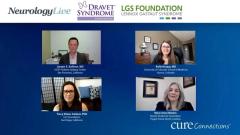
Newer Treatments for LGS
Dr Kelly Knupp examines data on fenfluramine and cannabidiol for the management of Lennox-Gastaut Syndrome.
Episodes in this series

Joseph E. Sullivan, MD: In these last few years despite having already a handful of FDA approved medications for treatment of LGS. There have been 2 newly approved medications. First was cannabidiol and then followed by fenfluramine, Kelly I'm wondering if you could just share your take on the data for those 2 studies and maybe comment on how you see them sort of fitting into your treatment algorithm or treatment approach.
Kelly Knupp, MD: It's nice that we had placebo-controlled studies for both of these products specifically in the Lennox-Gastaut population, and I will say before I even present numbers that the numbers looked better in the Dravet population than the Lennox-Gastaut population but it's important to keep in mind that the Dravet population is a very homogeneous population with a similar gene involved in the vast majority of those patients, whereas the Lennox-Gastaut population is a much more heterogeneous population. There may be sub-populations within there that respond better or worse and it's a little challenging to sort that out when you've only enrolled 60 or 70 patients in a study. That's important to keep in mind and there probably is more work that could be done in these sub-populations who have Lennox-Gastaut. Both fenfluramine and cannabidiol showed positive results and that is very exciting. While these are results in groups of people it's hard to know until you try it what the individual response is going to be. When we look at cannabidiol we saw a dose response with that at the lower dose which was a 10 mg per kilo per day, we saw a reduction of about 37% in seizures associated with a drop. It's important to also keep in mind what the outcome measures were. It's often reported as a drop seizure which many of us think of as an atonic seizure but that wasn't what the outcome measure was. The outcome measure was seizures associate with a drop so that's any seizure that led to a fall or could have led to a fall if the patient were sitting up or standing up. That's not just an atonic seizure. That could have been a tonic seizure and it could have been a generalized tonic clonic seizure so it's important to keep that in mind. At the lower dose of 10 mg per kilo per day there was a 37% reduction in drop seizures. At the 20 mg per kilo per day there was a 42% reduction in seizures and compare that to placebo which only had a 17% reduction in seizures. Clearly there was benefit at both the low dose and the high dose that was statistically significant for that population. Again, for an individual patient it's hard to know how they're going to respond but until you try it you're not really going to know. Fenfluramine likewise had a lower response rate in the LGS population compared to the Dravet population but again we have to keep in mind that these are heterogeneous populations when we're looking at Lennox-Gastaut. Overall, there was a 26% reduction in seizures compared to a 7.6 reduction in seizures in the placebo group so that was statistically significant. I think also in fenfluramine as we look at longer term data in the open label extension for the patients who stayed on fenfluramine overall they had a 66% reduction in all seizure types not just seizures associated with a drop and that is pretty notable. That tells me that there are probably sub-populations that responded better to fenfluramine within the LGS population and again we won't know who those patients are at an individual level until we try the medication. That is pretty significant to have that much of a reduction in seizures. We spoke earlier in our conversation about this hypothetical drop of 30% seizures, taking somebody from 1000 seizures a day to 700 seizures a day but boy to go from 1000 seizures a day to 400 seizures a day that's got to get close to improving some quality of life even though it's not perfect. It's a step in the right direction. It’s also notable in the fenfluramine study is that there was a small percentage of patients that were seizure free or nearly seizure free and as we've talked about Lennox-Gastaut that is not something that we really expect from any of our treatments. It's something we always hope for but not something that we set as a reasonable expectation and so to have a small percentage of patients that are seizure free or nearly seizure free in both of these populations, both the fenfluramine and the CBD population, is really notable and again we won't know for an individual patient until we try it if they're going to fall in that small percentage.
Joseph E. Sullivan, MD: We had spoken before that it's not that they're 2 studies that are comparing one to the other. They were very similar study designs. A lot of the patient background, they have been on a lot of the same medications so that theme of you won't know until you try it and then if you end up being one of those so-called super responders then that means a lot for that individual patient. I wish there was a way we could predict but it's just them being willing to try and hoping that you are one of those patients because then if you are you hopefully will be thankful that you did try it.
Transcript Edited for Clarity
Newsletter
Keep your finger on the pulse of neurology—subscribe to NeurologyLive for expert interviews, new data, and breakthrough treatment updates.





























